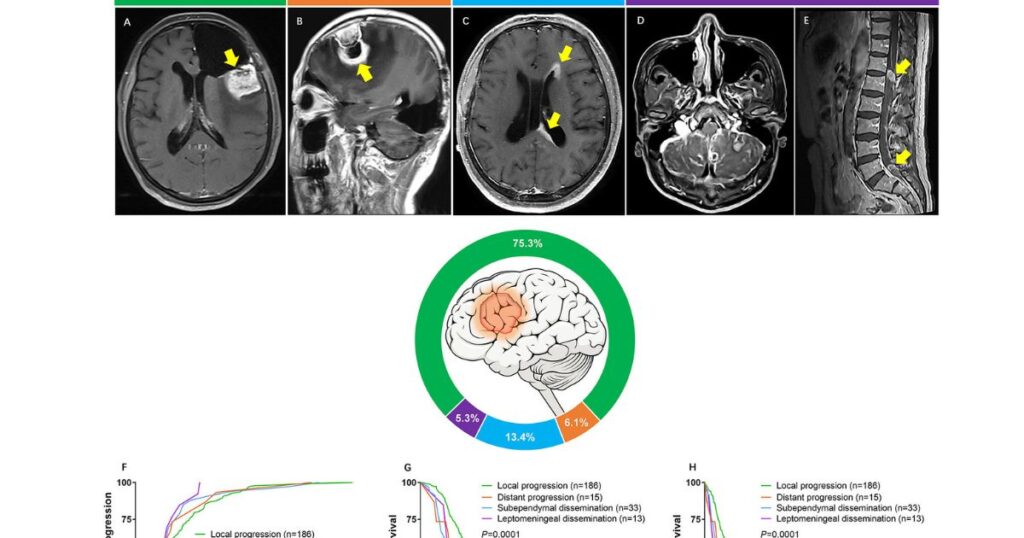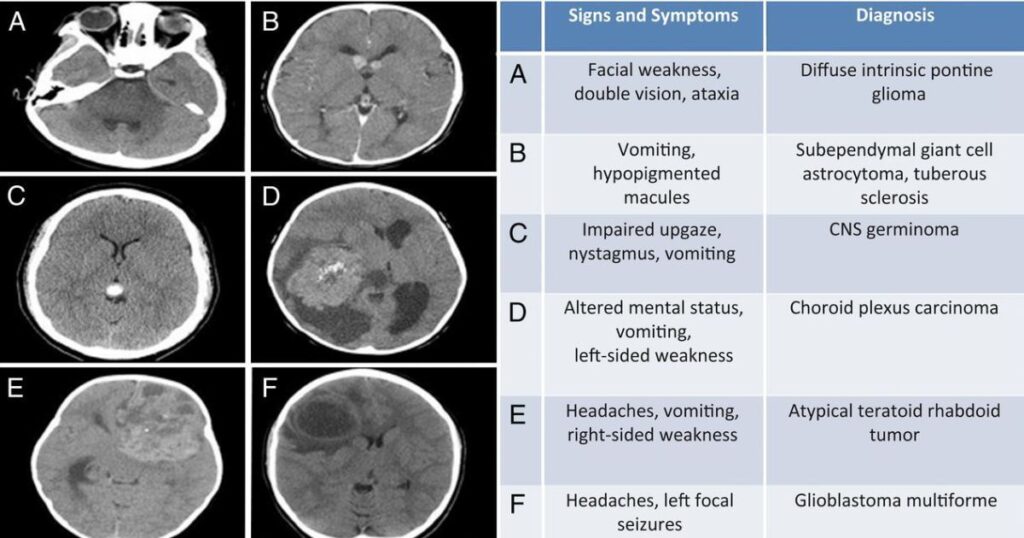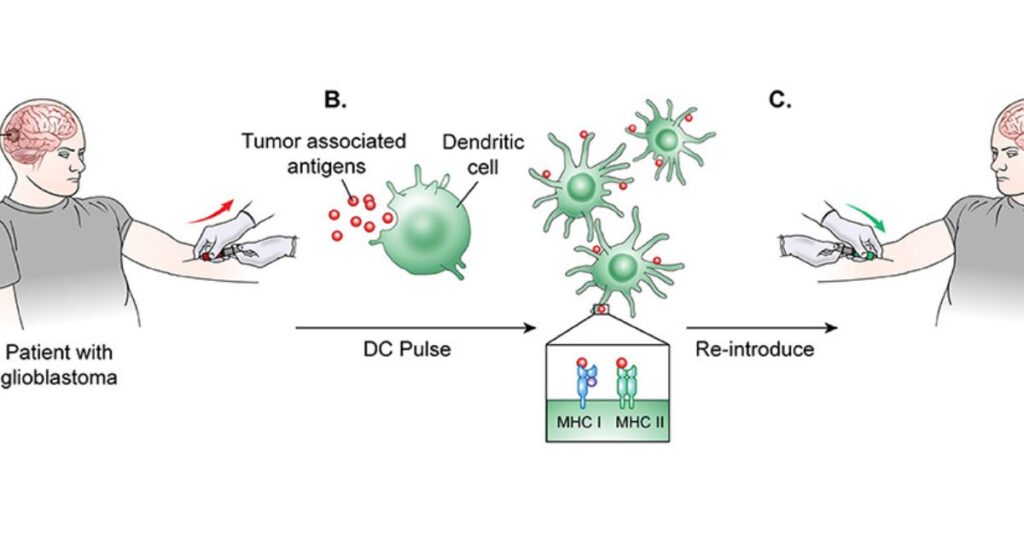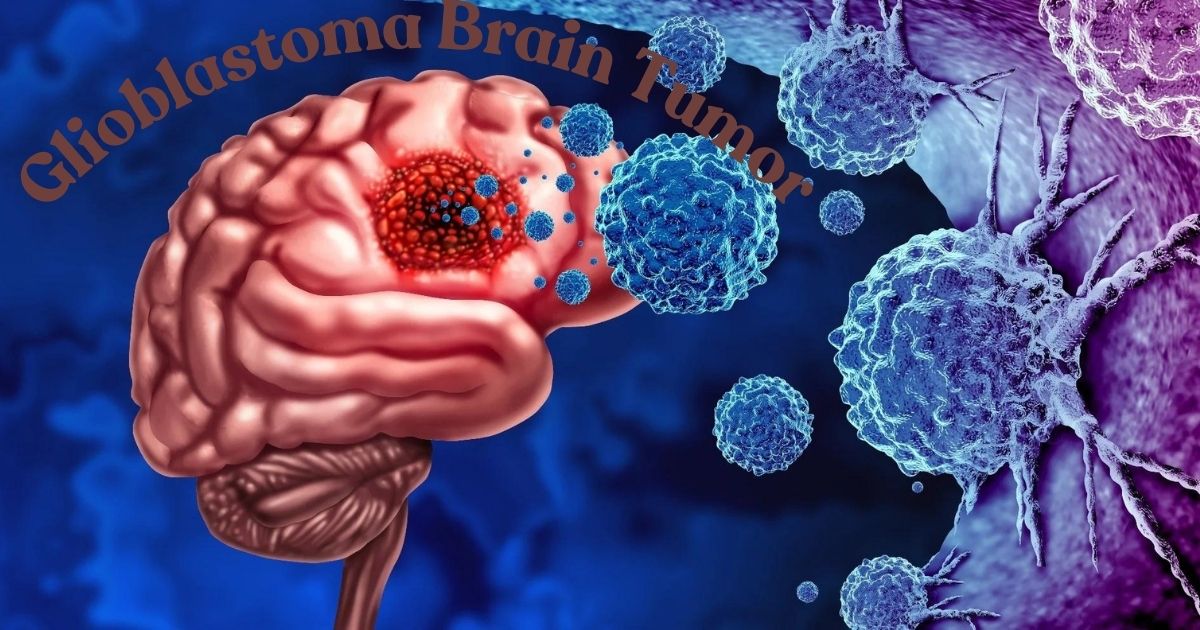Glioblastoma, also known as glioblastoma multiforme (GBM), is the most aggressive and common primary malignant brain tumor in adults. These fast-growing tumors arise from glial cells, which are supportive in the brain. Glioblastomas are known for their ability to infiltrate healthy brain tissue, making complete surgical removal challenging.
This article delves into the complexities of glioblastoma, exploring its symptoms, stages, prognosis, and potential causes. We will also discuss current treatment options and ongoing research efforts aimed at improving patient outcomes.
Read More: Digital News Planet
Glioblastoma Brain Tumor: Glioblastoma Symptoms
Early diagnosis of glioblastoma is crucial for maximizing treatment effectiveness. However, symptoms can vary depending on the tumor’s location and size. Some common glioblastoma symptoms include:
- Headaches: These are often persistent and progressively worsen, especially in the morning.
- Nausea and vomiting: These can occur frequently and may not be relieved by medication.
- Seizures: Seizures are a common symptom, particularly in individuals with no prior history of them.
- Vision problems: Blurred vision, double vision, or loss of peripheral vision can occur if the tumor affects the areas of the brain responsible for sight.
- Speech difficulties: Slurring of speech or difficulty finding words can indicate involvement of the brain regions controlling speech.
- Weakness or clumsiness: If the tumor affects the motor cortex, one-sided weakness or clumsiness on a particular side of the body can occur.
- Cognitive decline: Difficulty with memory, concentration, or problem-solving can be signs of tumor growth.
- Personality changes: Changes in mood, behavior, or personality can be associated with glioblastoma.

It is important to note that other conditions can also cause these symptoms. If you experience any of these symptoms, it’s crucial to consult a doctor for a proper diagnosis.
Glioblastoma Stages: Stage 4 and What to Expect
The World Health Organization (WHO) classifies brain tumors based on their cellular characteristics and how aggressive they are. Glioblastomas are classified as grade IV tumors, signifying the highest grade and most aggressive behavior.
Stage 4 Glioblastoma: What to Expect
A stage 4 glioblastoma diagnosis can be overwhelming. Here’s what you might expect:
- Treatment Plan: Your doctor will develop a personalized treatment plan based on various factors, including your overall health, tumor size and location, and the presence of mutations in specific genes.
- Surgery: If possible, surgery will likely be the first line of treatment. The goal is to remove as much of the tumor as safely as possible. However, complete removal is often challenging due to the infiltrative nature of glioblastomas.
- Radiation therapy: Radiation therapy uses high-energy beams to kill cancer cells. It is typically administered after surgery and may be combined with chemotherapy.
- Chemotherapy: Chemotherapy involves medication to destroy cancer cells throughout the body. It is often combined with radiation therapy.
- Clinical trials: Participating in clinical trials can provide access to promising new treatments not yet widely available.
The prognosis for stage 4 glioblastoma is challenging. The median survival rate is approximately 12-18 months with treatment. However, this can vary significantly depending on individual factors.

How Does Glioblastoma Kill You?
Glioblastoma can lead to death through several mechanisms:
- Increased intracranial pressure: As the tumor grows, it can increase pressure within the skull, causing damage to brain tissue and vital functions.
- Herniation: In severe cases, the pressure can cause brain tissue to shift and herniate, leading to life-threatening complications.
- Seizures: Uncontrolled seizures can be a cause of death, particularly if they lead to respiratory difficulties.
- Infection: The breakdown of the blood-brain barrier due to the tumor can increase the risk of diseases in the brain, which can be fatal.
- General health decline: The tumor and its treatment can significantly impact a person’s overall health and well-being, ultimately leading to complications and death.
Can You Prevent Glioblastoma?
Unfortunately, there is no known definitive way to prevent glioblastoma. However, some factors may increase your risk:
- Age: The risk of glioblastoma increases with age.
- Radiation exposure: Previous exposure to radiation therapy for other cancers can increase the risk.
- Family history: Having a close relative with glioblastoma may slightly elevate your risk.
- Certain genetic conditions: Inheriting specific genetic mutations can increase the risk of developing glioblastoma.
While these factors can influence risk, it’s important to remember that most glioblastoma cases occur in individuals with no known risk factors.
Glioblastoa Prognosis by Age

- Age: Generally, younger patients tend to have a slightly better prognosis than older patients. This may be due to a younger body’s better tolerance to treatment.
- Overall health: Patients with good overall health before diagnosis tend to have a better prognosis.
- Tumor size and location: Smaller tumors and those located in less critical brain regions are often associated with a better prognosis.
- Molecular makeup of the tumor: The presence or absence of specific genetic mutations can influence treatment response and prognosis.
Here’s a breakdown of the typical glioblastoma prognosis by age range:
- Younger adults (under 45): The median survival rate can range from 18 to 36 months with treatment.
- Middle-aged adults (45-65): The median survival rate is typically around 12-18 months with treatment.
- Older adults (over 65): The median survival rate can be lower, ranging from 6 to 12 months with treatment.
It is important to remember that these are just averages. Prognosis can vary significantly from person to person.
Glioblastoma Causes
The exact causes of glioblastoma are still not fully understood. However, researchers believe a combination of genetic and environmental factors may play a role. Some potential contributing factors include:
- Genetic mutations: Changes in specific genes can trigger uncontrolled growth of glial cells, leading to tumor formation.
- Ionizing radiation: Exposure to high doses of radiation, such as from radiation therapy for other cancers, can increase the risk.
- Certain chemicals: Exposure to certain chemicals like vinyl chloride has been linked to an increased risk, although the evidence is not conclusive.
- Chronic inflammation: Some studies suggest that chronic inflammation in the brain may contribute to glioblastoma development.
It is important to note that these are just potential risk factors, and exposure to them does not guarantee the development of glioblastoma.
How Long Can You Have Glioblastoma Before Symptoms?
The timeframe between glioblastoma development and the emergence of symptoms can vary significantly. The tumor may grow silently for some time before reaching a size that causes noticeable symptoms.
Several factors can influence how long it takes for symptoms to appear:
- Tumor growth rate: Aggressive tumors increase and may cause symptoms sooner than slow-growing tumors.
- Tumor location: Tumors located in critical brain regions are more likely to cause early symptoms.
- Individual variations: People’s sensitivity to changes in their brain function can vary.
In some cases, symptoms may only appear once the tumor is quite advanced. This highlights the importance of seeking medical attention if you experience any persistent or worsening neurological symptoms.
Glioblastoma Symptoms: Early Signs
Early glioblastoma symptoms can be subtle and easily mistaken for other conditions. Here are some potential early signs to be aware of:
- Mild headaches: Headaches that are new or different from your usual headaches can be a sign.
- Subtle changes in mood or behavior: Personality changes, irritability, or difficulty concentrating can be early indicators.
- Slight vision problems: Blurred vision, occasional double vision, or minor changes in peripheral vision may occur.
- Fatigue: Unexplained fatigue can be a significant symptom if it worsens over time.
- Balance problems: Minor issues with balance or coordination could be early signs.
Suppose you experience any of these symptoms, mainly if they are persistent or worsening. In that case, it’s crucial to consult a doctor for a proper diagnosis. Early detection and treatment can improve the chances of a successful outcome.
Current Treatment Options for Glioblastoma

The standard treatment approach for glioblastoma often involves a combination of therapies:
- Surgery: The goal is to remove as much of the tumor as safely as possible. However, complete removal is often challenging due to the infiltrative nature of glioblastomas.
- Radiation therapy: High-energy beams are used to kill cancer cells after surgery and may be combined with chemotherapy.
- Chemotherapy: Medications destroy cancer cells throughout the body. Temozolomide is a standard chemotherapy drug used for glioblastoma.
- Targeted therapy: These drugs target specific molecular pathways involved in tumor growth. While still under development, targeted therapies hold promise for future glioblastoma treatment.
- Clinical trials: Participation in clinical trials can provide access to promising new treatment options.
The specific treatment plan will be tailored to the individual patient’s needs and circumstances.
Ongoing Research and Future Directions
- Developing new and more effective drugs: Researchers are actively investigating targeted therapies, immunotherapies, and other novel drug approaches to more effectively and with fewer side effects target glioblastoma.
- Gene therapy: This approach involves modifying genes within tumor cells to make them more susceptible to treatment or to stop their growth.
- Oncolytic viruses: These are genetically engineered viruses that can infect and kill cancer cells.
- Immunotherapy: This approach aims to harness the body’s immune system to fight glioblastoma. Researchers are exploring various strategies to stimulate the immune system to recognize and destroy tumor cells.
- Personalized medicine: Tailoring treatment plans based on the specific genetic makeup of an individual’s tumor holds promise for improving treatment efficacy.
Living with Glioblastoma
A glioblastoma diagnosis can be life-altering. Here are some resources and tips for living with glioblastoma:
- Support groups: Connecting with other patients and their families can provide emotional support and valuable information.
- Palliative care: This type of care focuses on improving a patient’s quality of life by managing symptoms such as pain and fatigue.
- Rehabilitation: Rehabilitation services can help patients regain strength, balance, and cognitive function after surgery or other treatments.
- Maintaining a healthy lifestyle: Eating a nutritious diet, getting regular exercise, and managing stress can all contribute to a better quality of life.
Living with glioblastoma requires a robust support system and a proactive approach to managing the disease.
Conclusion
Glioblastoma is a challenging and aggressive form of brain cancer. However, ongoing research offers hope for improved treatment options and future breakthroughs. Early diagnosis, combined with a multimodal treatment approach, can help patients manage the disease and live a longer, more fulfilling life.
If you or someone you know has been diagnosed with glioblastoma, it’s crucial to seek expert medical advice and explore all available treatment options.
FAQs;
1: What is the life expectancy of a person with a glioblastoma?
The median life expectancy for glioblastoma patients who undergo treatment is approximately 12-18 months. However, this can vary significantly depending on individual factors.
2: Can I beat glioblastoma?
While there is currently no cure for glioblastoma, some patients can live for extended periods with treatment. Early diagnosis and a personalized treatment plan are crucial.
3: What happens before death by glioblastoma?
As the tumor grows, it can cause a variety of symptoms, including increased headaches, seizures, and cognitive decline. In severe cases, complications can lead to coma and death.
4: Who is most at risk for glioblastoma?
The risk of glioblastoma increases with age, with adults over 50 being most susceptible. Exposure to radiation, certain genetic conditions, and a family history can also increase risk.
5: What are the final stages of glioblastoma?
Glioblastoma is classified as a grade IV tumor, signifying the most aggressive stage. In the final stages, symptoms can become more severe, and the cancer may become resistant to treatment.
6: How painful is glioblastoma?
Glioblastoma itself may not cause direct pain. However, headaches, a common symptom, can be pretty painful. Treatment side effects and complications from the tumor’s growth can also cause pain.
7: Can glioblastoma be cured if caught early?
Unfortunately, there is no cure for glioblastoma at present. However, early detection allows for earlier intervention and potentially a longer lifespan with treatment.
8: What are the warning signs of glioblastoma?
Early signs of glioblastoma can be subtle. Be aware of persistent or worsening headaches, personality changes, vision problems, fatigue, or balance issues. If you experience any of these, consult a doctor.
9: Is glioblastoma always stage 4?
Yes, glioblastoma is always classified as a grade IV tumor, the most aggressive stage.
10: Is glioblastoma 100% fatal?
While glioblastoma is a severe illness with a poor prognosis, it is not necessarily 100% fatal. With treatment, some patients can live for several years.
11: What famous person died from glioblastoma?
Several celebrities have succumbed to glioblastoma, including Senator John McCain, Beau Biden, and musician Neil Peart.
12: What is the best treatment for glioblastoma?
The best treatment approach is typically a combination of therapies tailored to the individual patient.
13: What organ does glioblastoma affect?
Glioblastoma is a brain tumor affecting the brain, which is part of the central nervous system.
14: Can glioblastoma cause sudden death?
Sudden death from glioblastoma is uncommon but can occur in severe cases. Rapid tumor growth or complications can lead to life-threatening situations.
15: Does chemo shrink glioblastoma?
Chemotherapy, particularly temozolomide, can help slow down tumor growth and improve patient outcomes. However, it may not always shrink it completely.





